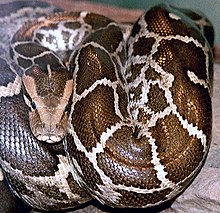
Back Luislange Afrikaans أصليات (فصيلة ثعابين) Arabic بيثونات ARZ Pitonlar Azerbaijani Пітоны Byelorussian Питонови Bulgarian অজগর Bengali/Bangla Naer-biton Breton Pitons (família) Catalan Pythonidae CEB
| Pythonidae | |
|---|---|

| |
| Indian python (Python molurus) | |
| Scientific classification | |
| Domain: | Eukaryota |
| Kingdom: | Animalia |
| Phylum: | Chordata |
| Class: | Reptilia |
| Order: | Squamata |
| Suborder: | Serpentes |
| Superfamily: | Pythonoidea |
| Family: | Pythonidae Fitzinger, 1826 |
| Synonyms | |
| |
This article needs additional citations for verification. (November 2022) |

The Pythonidae, commonly known as pythons, are a family of nonvenomous snakes found in Africa, Asia, and Australia. Among its members are some of the largest snakes in the world. Ten genera and 39 species are currently recognized. Being naturally non-venomous, pythons must constrict their prey to suffocate it prior to consumption. Pythons will typically strike at and bite their prey of choice to gain hold of it; they then must use physical strength to constrict their prey, by coiling their muscular bodies around the animal, effectively suffocating it before swallowing whole. This is in stark contrast to venomous snakes such as the rattlesnake, for example, which delivers a swift, venomous bite but releases, waiting as the prey succumbs to envenomation before being consumed. Collectively, the pythons are well-documented and -studied as constrictors, much like other non-venomous snakes, including the boas and even kingsnakes of the New World.[2]
Pythons are found in regions like sub-Saharan Africa, Southeast Asia, and Australia, with an invasive population of Burmese pythons in the Everglades National Park, Florida. They are ambush predators that primarily kill prey by constriction, causing cardiac arrest. Pythons are oviparous, laying eggs that females incubate until they hatch. They possess premaxillary teeth, with the exception of adults in the Australian genus Aspidites.[3][4] While many species are available in the exotic pet trade, caution is needed with larger species due to potential danger. The taxonomy of pythons has evolved, and they are now more closely related to sunbeam snakes and the Mexican burrowing python.
Pythons are poached for their meat and skin, leading to a billion-dollar global trade. They can carry diseases, such as salmonella and leptospirosis, which can be transmitted to humans. Pythons are also used in African traditional medicine to treat ailments like rheumatism and mental illnesses. Their body parts, including blood and organs, are believed to have various healing properties. In some African cultures, pythons have significant roles in folklore and mythology, often symbolizing strength or having sacred status.
- ^ McDiarmid, Roy W.; Campbell, Jonathan A.; Touré, T'Shaka A. (1999). Snake Species of the World: A Taxonomic and Geographic Reference. Vol. 1. Herpetologists' League. ISBN 978-1-893777-01-9.
- ^ "Pythonidae". Integrated Taxonomic Information System. Retrieved 9 December 2019.
- ^ Constrictores Oppel, 1811 – the available name for the taxonomic group uniting boas and pythons
- ^ Patterns of postnatal ontogeny of the skull and lower jaw of snakes as revealed by micro‐CT scan data and three‐dimensional geometric morphometrics
© MMXXIII Rich X Search. We shall prevail. All rights reserved. Rich X Search